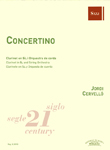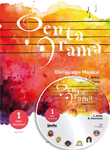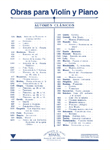El rapte de les Sabines
Partitura general
Symphonyc Orchestra
BLANCAFORT, ManuelReg.: B.3184
26,60 €
P.V.P. (VAT included 4%)
Add to cart
- Ensemble: Symphonic orchestra: .
- Genres: Classical / contemporary: Symphonic.
- Product format: Partitura
- Difficulty level: Advanced-superior
- Period: 2nd half S. XX - XXI
- Publishing house: Editorial Boileau
- Collection: Siglo XXI
- No. of pages: 76
- Measure: 31,00 x 23,00 cm
- Lenght: 13'00"
- ISBN: 978-84-8020-761-4
- ISMN: 979-0-3503-0303-6
- Available in digital: No
- Available for rent: Yes
3[1.2.pic/3] 3[1.2.Eh] 3[1.2.bcl] 3[1.2.cbn] — 4 3 3 1 — tmp+3 — cel — hp — str
perc: tri, sd, bd, tmbn, cym, ttam
THE MATERIALS HAVE TO BE HIRED
Symphonic overture thought, initially, for a ballet with a storyline by the novelist Francesc Trabal. Commissioned by the Mayor of Barcelona, M. Mateu.
Released in the third fall concert, serie XXIV, on october 19th, 1932, in Barcelona by the Patronage Orchestra directed by Pau Casals.
This symphonic work was originally conceived as a ballet based on an idea by the novelist Francesc Trabal. It was a commission by the Mayor of Barcelona Miquel Mateu i Pla and has a duration of approximately 13 minutes.
It was premiered in Barcelona in the third autumn concert, Series XXIV, on October 19, 1932, by the Orquesta del Patronato directed by Pau Casals. The work was performed again on October 23, 1987, in the series Catalan Contemporary Music directed by M. Swierczewski.
Joan Gibert Camins wrote in La Publicitat (October 21, 1932): «In this composition, the composer reveals an extraordinary advance in the art of composition and especially in orchestration. His orchestral writing sounds fluid and agile. It has what we might call the grace of colour and exquisite good taste in the play of the various sonorities and the selection of timbres.
The music of the Rape is not transcendent, but on the other hand, it is extraordinarily dynamic, with a great richness of rhythm and counterpoint, subtle harmonies that, at times, make us think of Ravel. We especially like the first scene of the ballet, the dances of the Sabines by the fountain, a delicious rondo with elegant rhythm and perfect touches of imitation using the celeste and percussion.
The appearance of the dragon interrupts this pastoral scene. At the most humorous moment of the music, the allusion to the theme of the theme of the Andante of the 5th Symphony of Beethoven is a sort of intellectual game, since Blancafort needed a theme for his dragon “that made him be respected”.
It seems to us that no one will deny that the theme he selected is not so very serious. The fugue that follows describing the anxiety of the Sabines is very graceful. The theme is festive with a grotesque unease and somewhat home-like, as if the ladies were cleaning the house, although its rhythm is lively and agile and has a nicely moulded sense. Nevertheless, the development of this fugue is important and, in spite of its dimension and the lack of stage action, the listener never loses interest for a moment. Also very successful is the brass in the war songs and the contrast that follows, when everything begins dying down, and finally there is only a beautiful “coda” full of poetry.»









